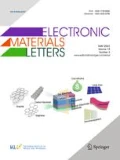Abstract
Numerical modelling has emerged as a powerful tool for the development and optimization of directional solidification process for mass production of multicrystalline silicon. A transient global heat transfer model is performed to investigate the effect of bottom grooved furnace upon the directional solidification (DS) process of multi-crystalline silicon (mc-Si). The temperature distribution, von Mises stress, residual stress and dislocation density rate in multi-crystalline silicon ingots grown by modified directional solidification method have been investigated for five growth stages using finite volume method at the critical Prandtl number, Pr = 0.01. This paper discusses bottom groove furnace instead of seed crystal DS method. It achieves an advanced understanding of the thermal and mechanical behaviour in grown multi-crystalline ingot by bottom grooved directional solidification method. The von Mises stress and dislocation density were reduced while using the bottom grooved furnace. This work was carried out in the different grooves of radius 30 mm, 60 mm and 90 mm of the heat exchanger block of the DS furnace. In this paper, the results are presented for 60 mm radius groove only because it has got better results compared to the other grooves. Also, the computational results of bottom grooved DS method show better performance compared the conventional DS method for stress and dislocation density in grown ingot.

Similar content being viewed by others
References
L. Sun, L. Liu, Z. Li, and W. Zhao, Materials for Renewable Energy and Environment, 1, 95 (2011).
G. Muller and G. Friedrich, AIP Conf. Proc. 1270, 255 (2008).
J. W. Shur, B. K. Kang, S. J. Moonb, W. W. Sob, and D. H. Yoon, Sol. Energ. Mat. Sol. C. 95, 3159 (2011).
A. F. B. Braga, S. P. Moreira, P. R. Zamperi, J. M. G. Bacchin, and P. R. Mei, Sol. Energ. Mat. Sol. C. 92, 418 (2008).
K. Nakajima, K. Kutsukake, K. Fujiwara, K. Morishita, and S. Ono, J. Cryst. Growth 319 13 (2011).
T. F. Li, H. C. Huang, H. W. Tsai, A. Lan, C. Chuck, and C. W. Lan, J. Cryst. Growth 340, 202 (2012).
T. F. Li, K. M. Yeh, W. C. Hsu, and C. W. Lan, J. Cryst. Growth 318, 219 (2011).
N. G. Zhou, M. H. Lin, L. Zhou, Q. F. Hu, H. S. Fang, and S. Wang, J. Cryst. Growth 381, 22 (2013).
X. Yang, W. Ma, G. Lv, K. Wei, T. Luo, and D. Chen, J. Cryst. Growth 400, 7 (2014).
J. Wei, H. Zhang, L. Zheng, C. Wang, and B. Zhao, Sol. Energ. Mat. Sol. C. 93, 1531 (2009).
T. Y. Wang, S. L. Hsu, C. C. Fei, K. M. Yei, W. C. Hsu, and C. W. Lan, J. Cryst. Growth 311, 263 (2009).
Q. Chen, Y. Jiang, J. Yan, and M. Qin, Prog. Nat. Sci. 18, 1465 (2008).
W. Ma, G. Zhong, L. Sun, Q. Yu, X. Huang, L. Liu, and G. Chen, Sol. Energ. Mat. Sol. C. 100, 231 (2012).
L. Braescu and T. Duffar, J. Cryst. Growth 310, 484 (2008).
J. W. Huang, W. S. Hwang, C. H. Hwang, and Y. W. Chang, IOP Conf Series: Materials Science and Engineering 33, 012059 (2012).
J. Fainberg and H. J. Leister, Comput. Method. Appl. M. 137, 167 (1996).
H. Alexander and P. Haasen, Solid State Phys. 22, 27 (1968).
S. Nakano, X. J. Chen, B. Gao, and K. Kakimoto, J. Cryst. Growth 318, 280 (2011).
J. P. Hirth and J. Lothe, Theory of Dislocations, Krieger Publishing Company, Malabar, USA (1983).
W. Zhao, L. Liu, L. Sun, and A. Geng, J. Cryst. Growth 401, 296 (2014).
Author information
Authors and Affiliations
Corresponding author
Rights and permissions
About this article
Cite this article
Srinivasan, M., Karuppasamy, P., Ramasamy, P. et al. Numerical modelling on stress and dislocation generation in multi-crystalline silicon during directional solidification for PV applications. Electron. Mater. Lett. 12, 431–438 (2016). https://doi.org/10.1007/s13391-016-4002-3
Received:
Accepted:
Published:
Issue Date:
DOI: https://doi.org/10.1007/s13391-016-4002-3


